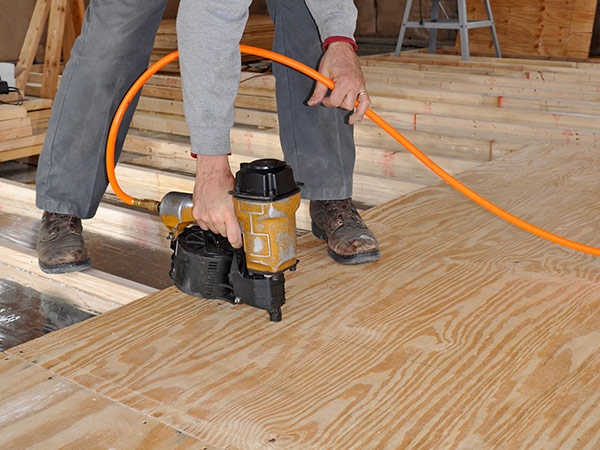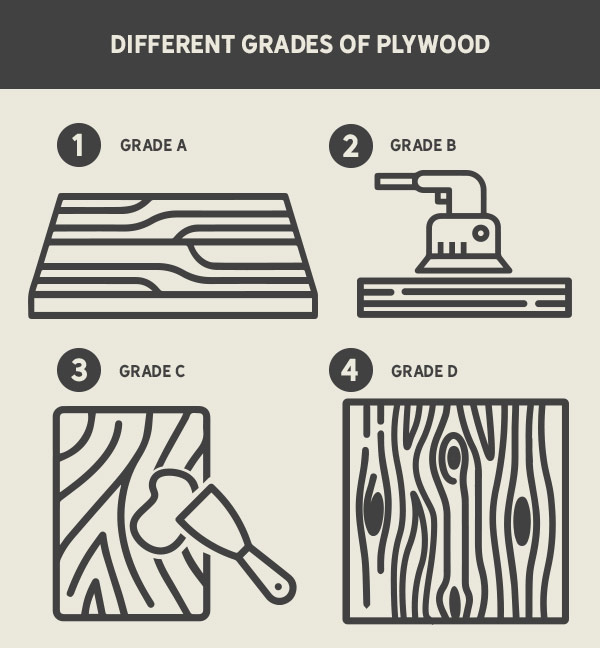

What is Plywood, Anyway?
Just about any construction project includes plywood. But what is plywood? This common building material is anything but simple. In fact, it’s an engineering marvel! We love using different types of plywood in tons of projects from furniture to additions to whole home construction — but do you really know what makes plywood so strong and so affordable? Read on to learn more about this super material.
Learn Your Plywood Basics, Starting with Its History
If you’re wondering about plywood’s origin story, you have to go way back in the history books. It is, at its basic definition, a minimum of three layers of cross-laminated veneer wood, or “plies.” They are affixed together using adhesives and immense heat and pressure. This construction technique in fact had its start in ancient Egypt, and the earliest found examples date from 2600 BC. What the Egyptians discovered is that when you affix thin veneers of wood in alternating grains, you create a strong, flexible wood sheet that has many uses.
While the Egyptians invented plywood, it wasn’t until the late 1800s and early 1900s that it became a product that could be created in large numbers, through industrial production. And while we may consider modern plywood just a construction material, in fact, its use has found fame over the years as now famous designers chose to use types of plywood in their iconic furniture due to its versatility and flexibility. In fact, many modern home designs use this affordable product to add visual interest to interiors.
What Makes Plywood Stick Together?
One of the benefits to using plywood, especially in climates that get very hot or very cold throughout the year, is that it won’t shrink or expand like other lumber will. It is held together with adhesives, often specially designed resins that help it keep its shape and strength, but also provide reliability for the finished product in different environments. While many manufacturers use formaldehyde resins, products such as plytanium sanded panels (available at McCoy’s) do not have added urea formaldehyde resins.


How Plywood is Used in Modern Construction
In most construction projects, such as one you’d head to McCoy’s for, plywood is mostly made from softwoods. The sizes of the panels are standardized:
- 4 ft. x 4 ft.
- 4 ft. x 8 ft.
- 4 ft. x 9 ft.
The thickness of plywood can range from very thin, 1/8 in. thick wood, up to 1 1/2 in. thick — though the most common thicknesses you’ll encounter in construction are 1/2 in. thick to 1 in. thick panels.
In most construction projects, unless you’re planning a big design piece, you’ll use plywood behind the scenes. It’s found in key points in roofing, siding, subflooring, and other areas that need its strong, affordable presence to hold up to anything Mother Nature can throw at a building over its lifetime.


How Does Plywood Get "Graded"?
When you’re picking out plywood for your project, you’ll want to pay attention to the grade which is frequently stamped on each sheet. It comes in different grades, ranging from A to D.
- Grade A: Has a defect-free, smooth face and back that is ideal for staining, painting, or even leaving exposed, such as for high-end modern design projects where plywood is visible.
- Grade B: Less expensive than Grade A, this plywood can contain some defects that are then “patched” or filled while the sheet is produced. It has been sanded smooth and might need to be stained or painted if exposed.
- Grade C: This type of plywood is unsanded and may have large knots and patches. This is commonly used in more “hidden” areas where plywood’s strength and affordability can shine, such as in subflooring.
- Grade D: This type of plywood is also unsanded but contains even larger knot holes and more patches. It is also used in unseen areas and sheathing, such as in subfloors or roofing.
Plywood also comes in types that combine attributes of different grades on the “face” (front) or back of the board for various uses. The wood core may also vary, which is indicated by the panel’s grade stamp. The most common grades you’ll encounter in general construction projects are rated CD, BC, and AC.
Another example of plywood grades that are commonly used are those rated for EXT (exterior) and INT (interior) exposures. This can come into play when planning a construction project and the conditions it could come into contact with. Plywood comes in varieties that are noted as Exposure 1, Exposure 2, Interior, and Structural 1 grades, as well. These are all indications of the types of adhesives (glues) used in the plywood construction, and whether they are intended to withstand interior conditions or exterior.
The letter X in plywood grades doesn’t indicate “exterior,” but instead notes the type of glue used between the plys. X-graded wood can withstand some moisture for a time but should be covered eventually. CDX plywood is commonly used for projects such as building exterior walls (which are then covered by something like bricks or siding).
If you’re planning a project such as building a boat, look for “marine” grade that is designed to come into contact with water. No boat projects? Marine grade plywood also comes in handy in very hot and humid conditions, such as in a sauna or damp bathroom, where it needs to hold up to the steamiest air around. You might see moisture-resistant plywood graded as MR (moisture resistant), BWR (highly moisture resistant), or simply Marine.
Finally, plywood can be additionally “pressure treated” to make it even stronger, harder, and less susceptible to decay or insect damage. Pressure treated can come with many possibilities, but it also comes with disadvantages due to the treatment process which renders the final product unsuitable for indoor applications. It also can shrink, which should be taken into account if you decide to use it in a construction project.
Tongue-and-groove plywood is sought after for subflooring due to its ability to prevent “bounce” in floors as it fits together so perfectly. It creates a strong, rigid subfloor through use of cutouts in the form of “tongues” and “grooves” which fit together (sometimes with a little muscle) to create a tight structure.
Products Sometimes Used Instead of Plywood in Construction
If plywood isn’t the right engineered wood for your project, some other interesting options may work for you. Particle board isn’t as strong as plywood, but it does tend to cost less. Particle board is often used in “finished” products, however, since it is often smoother and can be painted easily. You may have particle board in bookcases in your home, or in items such as kitchen cabinets, desks, or any number of common mass-produced items.
Another option is MDF, or medium-density fiberboard which has no visible knots and is very smooth, thanks to its use of many small wood fibers, instead of peeled sheets of wood. MDF tends to be cheaper and harder than plywood, and it’s easier to use in projects where wood needs to be carved. Finally, OSB, or oriented-strand board, is another engineered option that may work best for your project, especially if you’d like to use products made from fast-growing trees for a greener footprint. Read more about OSB and its benefits in construction projects.
Why Go to McCoy's for Plywood?
Plywood isn’t as simple as you might first assume. It comes in many different grades, sizes, thicknesses, and price points that can all impact your project’s success and bottom line. When you come to McCoy’s, our experts can help you select the perfect sheets of plywood to make your project a win.

